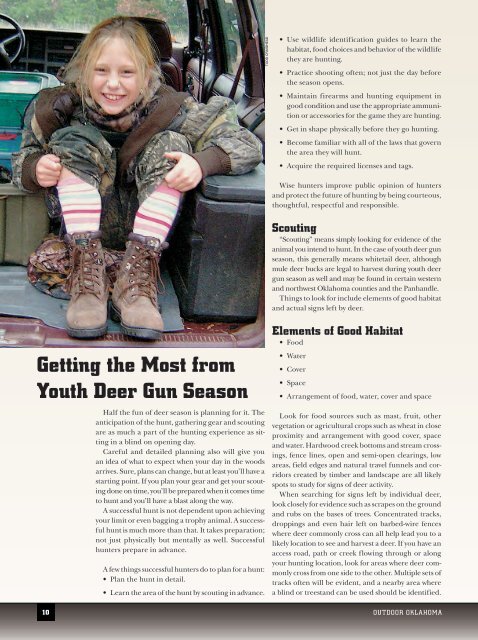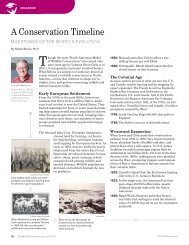Youth Deer Gun Season - Oklahoma Department of Wildlife ...
Youth Deer Gun Season - Oklahoma Department of Wildlife ...
Youth Deer Gun Season - Oklahoma Department of Wildlife ...
Create successful ePaper yourself
Turn your PDF publications into a flip-book with our unique Google optimized e-Paper software.
Getting the Most from<br />
<strong>Youth</strong> <strong>Deer</strong> <strong>Gun</strong> <strong>Season</strong><br />
10<br />
Half the fun <strong>of</strong> deer season is planning for it. The<br />
anticipation <strong>of</strong> the hunt, gathering gear and scouting<br />
are as much a part <strong>of</strong> the hunting experience as sitting<br />
in a blind on opening day.<br />
Careful and detailed planning also will give you<br />
an idea <strong>of</strong> what to expect when your day in the woods<br />
arrives. Sure, plans can change, but at least you’ll have a<br />
starting point. If you plan your gear and get your scouting<br />
done on time, you’ll be prepared when it comes time<br />
to hunt and you’ll have a blast along the way.<br />
A successful hunt is not dependent upon achieving<br />
your limit or even bagging a trophy animal. A successful<br />
hunt is much more than that. It takes preparation;<br />
not just physically but mentally as well. Successful<br />
hunters prepare in advance.<br />
A few things successful hunters do to plan for a hunt:<br />
• Plan the hunt in detail.<br />
• Learn the area <strong>of</strong> the hunt by scouting in advance.<br />
TODD CRAIGHEAD<br />
• Use wildlife identification guides to learn the<br />
habitat, food choices and behavior <strong>of</strong> the wildlife<br />
they are hunting.<br />
• Practice shooting <strong>of</strong>ten; not just the day before<br />
the season opens.<br />
• Maintain firearms and hunting equipment in<br />
good condition and use the appropriate ammunition<br />
or accessories for the game they are hunting.<br />
• Get in shape physically before they go hunting.<br />
• Become familiar with all <strong>of</strong> the laws that govern<br />
the area they will hunt.<br />
• Acquire the required licenses and tags.<br />
Wise hunters improve public opinion <strong>of</strong> hunters<br />
and protect the future <strong>of</strong> hunting by being courteous,<br />
thoughtful, respectful and responsible.<br />
Scouting<br />
“Scouting” means simply looking for evidence <strong>of</strong> the<br />
animal you intend to hunt. In the case <strong>of</strong> youth deer gun<br />
season, this generally means whitetail deer, although<br />
mule deer bucks are legal to harvest during youth deer<br />
gun season as well and may be found in certain western<br />
and northwest <strong>Oklahoma</strong> counties and the Panhandle.<br />
Things to look for include elements <strong>of</strong> good habitat<br />
and actual signs left by deer.<br />
Elements <strong>of</strong> Good Habitat<br />
• Food<br />
• Water<br />
• Cover<br />
• Space<br />
• Arrangement <strong>of</strong> food, water, cover and space<br />
Look for food sources such as mast, fruit, other<br />
vegetation or agricultural crops such as wheat in close<br />
proximity and arrangement with good cover, space<br />
and water. Hardwood creek bottoms and stream crossings,<br />
fence lines, open and semi-open clearings, low<br />
areas, field edges and natural travel funnels and corridors<br />
created by timber and landscape are all likely<br />
spots to study for signs <strong>of</strong> deer activity.<br />
When searching for signs left by individual deer,<br />
look closely for evidence such as scrapes on the ground<br />
and rubs on the bases <strong>of</strong> trees. Concentrated tracks,<br />
droppings and even hair left on barbed-wire fences<br />
where deer commonly cross can all help lead you to a<br />
likely location to see and harvest a deer. If you have an<br />
access road, path or creek flowing through or along<br />
your hunting location, look for areas where deer commonly<br />
cross from one side to the other. Multiple sets <strong>of</strong><br />
tracks <strong>of</strong>ten will be evident, and a nearby area where<br />
a blind or treestand can be used should be identified.<br />
OUTDOOR OKLAHOMA







